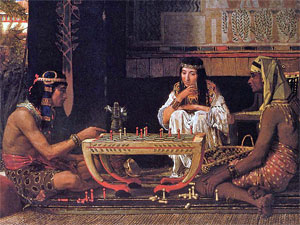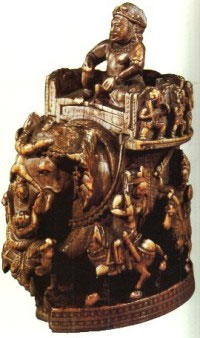With the new content management of our news page the well-loved puzzle
section, which was published in static HTML, disappeared into oblivion.
Readers are still asking about it, and so we have decided to republish the
articles, some of which are over ten years old, in our new format. For older
readers the cherries we will pick out of the original section will hopefully
bring on nostalgic memories; younger readers will learn for the first time
what we have been up to over the years.
A thousand-year-old chess problem
By Frederic Friedel
It would probably not be very inaccurate to say that chess was invented
in 570 A.D. somewhere in the north-eastern part of India. In manuscripts
from the early 7th century a game called “Chaturanga” (which
later changed to “Shatranj”) is suddenly mentioned, a precursor
of chess as we know it today. Naturally we cannot be sure that there were
no earlier forms, but the evidence seems to suggest that the game was invented
from scratch by a single person in this area of the world at around this
period of time.
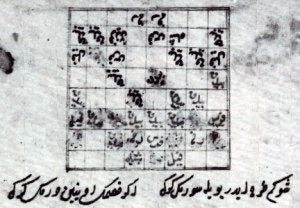
|
|
The rules of Shatranj were very similar to those modern chess. The game
was played on a board with 64 dark and light squares, with pieces that we
would find quite familiar. It was based on the army formation of the period.
There was an infantry (padati, today’s pawns), elephants
(hasti, our bishops – but in Russia they are still called
elephants), the cavalry (ashwa, the knights), chariots (rat-ha,
today rooks) and a vizier or councellor (mantri), which later became
a queen. The elephants could only move two squares diagonally, and jump
over pieces; the vizier moved one square in any direction. But everything
else was much the way it is today.
The king is dead
Wars at the time were decided either by the complete annihilation of the
enemy army or by the capture of the enemy king. This was also reflected
in Chaturanga. The most important piece was the raja or king, whose survival
decided on victory or loss in the game. When the Persians took over the
game they called this piece the “Shah” and ended a game with
the words “Shah mat!”, “the king is defeated”.
This is still retained in the word “checkmate”, which actually
comes from 7th century Persia!
Mansuba
When the Arabs stormed Europe in the 9th century they brought the game
of chess with them. They also introduced the first “mansuba”,
which consisted of composed middle or endgame positions with well-defined
tasks, e.g. white to play and win. There were often stories and legends
surrounding the mansubat. One of the best-known is “Dilaram’s
mate”. We find it in a 15th century chess book by Firdewsi at-Tahihal,
who incidentally also authored the longest poem in history (with almost
a million verses, which took him 50 years to write). But the position and
story originates in the 10th century and probably comes from the Arab chess
teacher as-Suli.
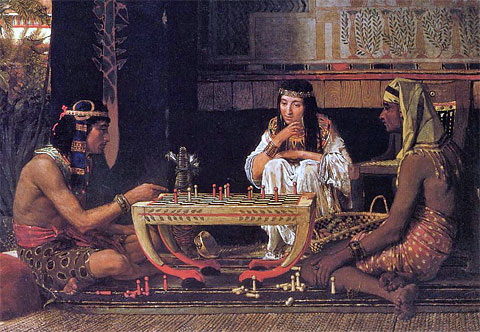
Arab Chess – painting by Sir Lawrence
Alma-Tadema [Source: Wikimedia]

The piece on h3 is an Alfil (A), which developed into our bishop
but which at the time could only move two squares diagonally and jump over
pieces (e.g. the knight on g4).
The story is that a chess-addicted prince, Murwardi, had wagered and lost
his entire fortune in an intense chess session. In his desperation he offered
his beautiful wife Dilaram as stake, and was losing the game they were playing
for her. In the above position his wife called out to him: "Oh Prince,
sacrifice your rooks and not your wife." This her husband duly did
and saved her with a combination the student is expected to find: 1.Rh8+
Kxh8 2.Af5+ Kg8 3.Rh8+ Kxh8 4.g7+ Kg8 5.Nh6 mate.
Addendum: Abner Díaz of Costa Rica tells us
that there is a similar double rook sacrifice if you replace the Alfil on
h3 with a regular knight. Then it becomes a regular modern chess problem.
Here's an ancient mansuba in which the difference in pieces and rules does
not play a role. It was composed more than a thousand years ago by a certain
al-Adli.
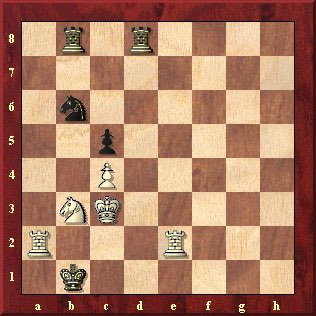
Black to move wins
In this hopeless position, with White threatening immediate mate by Ra1
or Reb2, Black must not just defend but actually win the game.
The solution
> 1...Na4+ 2.Rxa4 Rxb3+ 3.Kxb3 Rd3# 1-0
<
Highlight the line above to view the solution.
